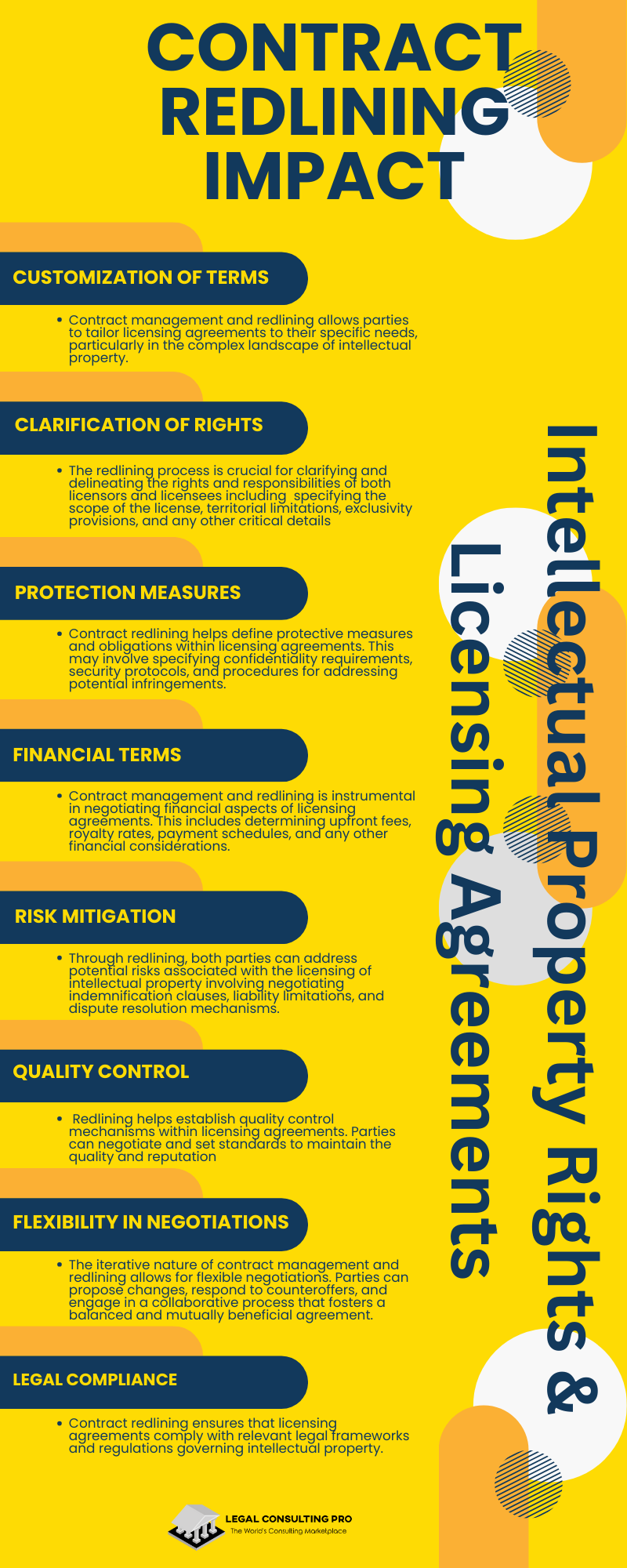In the complex landscape of business agreements, the process of making alterations to contracts, commonly referred to as redlining, holds significant implications for intellectual property rights and licensing agreements. This transformative process serves as the focal point of this article, wherein we delve into the multifaceted dimensions of contract redlining and its profound effects on intellectual property. Additionally, we will underscore the critical importance of efficient contract management in navigating these intricate negotiations.
What is Contract Redlining?
Contract management and redlining is a meticulous and collaborative process involved in reviewing and revising legal documents, particularly contracts, during the negotiation phase of a business deal. This practice is often employed by parties engaged in a transaction to propose changes, comment on specific clauses, and negotiate terms within a contract. The term “redlining” originates from the traditional practice of using a red pen to mark or highlight suggested modifications directly on a paper document.
The process of contract redlining plays a vital role in ensuring that all parties involved in a business agreement are in agreement with the terms and conditions laid out in the contract. It is a dynamic and iterative procedure, allowing for effective communication and negotiation between parties before finalizing the contractual agreement.
In the context of intellectual property rights and agreements related to the use or sharing of these assets, contract redlining becomes particularly crucial. Intellectual property, which includes patents, trademarks, copyrights, and trade secrets, often involves complex legal considerations. Parties engaged in such agreements need to be precise in defining rights, obligations, and limitations associated with the use, transfer, or sharing of intellectual property assets.
Intellectual Property Rights and Licensing Agreements: Explanation
Intellectual Property Rights (IPR) and Licensing Agreements are fundamental concepts in the field of law that govern the use, protection, and commercialization of intellectual property (IP). Let’s delve into each concept to understand their significance:
Intellectual Property Rights (IPR):
Intellectual Property refers to creations of the mind, such as inventions, literary and artistic works, designs, symbols, names, and images used in commerce. Intellectual Property Rights are legal protections granted to the creators or owners of these intellectual creations, providing them exclusive rights to use, distribute, and derive financial benefit from their intellectual efforts.
Licensing Agreements:
A Licensing Agreement is a legal contract between the owner of intellectual property (licensor) and another party (licensee) that grants the licensee permission to use, sell, or distribute the intellectual property under specified conditions. Licensing agreements are prevalent in various industries and are a crucial aspect of IP commercialization.
In summary, Intellectual Property Rights establish legal protections for creative and innovative works, while Licensing Agreements facilitate the controlled use and commercialization of these intellectual assets. Both concepts are essential components of the legal framework governing innovation, creativity, and business transactions in today’s knowledge-based economy.
Redlining in Intellectual Property
In the realm of intellectual property, redlining is a valuable tool employed during the negotiation and drafting of contracts to define the terms and conditions governing the use, transfer, and protection of intellectual property assets, such as patents, trademarks, copyrights, and trade secrets.
Contract Redlining in intellectual property negotiations serves as a critical step in creating clear, comprehensive, and mutually agreeable contracts. It empowers parties to actively participate in the shaping of contractual terms related to the use and protection of intellectual property assets, fostering transparency and reducing the potential for future conflicts. The integration of digital tools further enhances the efficiency and effectiveness of this essential negotiation process in the dynamic field of intellectual property law.
Redlining in Licensing Agreements
In the context of licensing agreements, “redlining” refers to the process of reviewing, editing, and negotiating specific terms within the contract. It involves marking proposed changes, additions, or deletions directly on the contract document, typically using a different color (commonly red), to indicate areas that require attention or modification. This collaborative editing process allows both parties—the licensor and the licensee—to suggest revisions, clarify terms, and negotiate until a mutually acceptable agreement is reached.
Redlining in licensing agreements is an essential part of the negotiation process, providing transparency, clarity, and a structured approach to reaching a final agreement. It allows both the licensor and licensee to actively participate in shaping the terms of the license, fostering a collaborative and mutually beneficial relationship.
Impact of Contract Redlining on Intellectual Property Rights and Licensing Agreements
Contract management and redlining have a profound impact on Intellectual Property Rights (IPR) and Licensing Agreements, significantly influencing the negotiation, protection, and utilization of intellectual property assets. In the realm of IPR and licensing, contract redlining plays a pivotal role in several key aspects:
- Customization of Terms: Contract management and redlining allow parties to tailor licensing agreements to their specific needs, particularly in the complex landscape of intellectual property. It enables the negotiation of terms related to usage rights, restrictions, and conditions for the use of patented technologies, copyrighted materials, trademarks, and other intellectual property assets.
- Clarification of Rights: The redlining process is crucial for clarifying and delineating the rights and responsibilities of both licensors and licensees. This includes specifying the scope of the license, territorial limitations, exclusivity provisions, and any other critical details related to the use and exploitation of intellectual property.
- Protection Measures: Contract redlining helps define protective measures and obligations within licensing agreements. This may involve specifying confidentiality requirements, security protocols, and procedures for addressing potential infringements, thereby safeguarding intellectual property from unauthorized use.
- Financial Terms: Contract management and redlining are instrumental in negotiating the financial aspects of licensing agreements. This includes determining upfront fees, royalty rates, payment schedules, and any other financial considerations related to the licensing of intellectual property.
- Risk Mitigation: Through redlining, both parties can address potential risks associated with the licensing of intellectual property. This may involve negotiating indemnification clauses, liability limitations, and dispute resolution mechanisms to minimize legal uncertainties and mitigate potential disputes.
- Quality Control: Redlining helps establish quality control mechanisms within licensing agreements. Parties can negotiate and set standards to maintain the quality and reputation of the licensed intellectual property, ensuring that the brand integrity or technological innovation is upheld.
- Flexibility in Negotiations: The iterative nature of contract management and redlining allows for flexible negotiations. Parties can propose changes, respond to counteroffers, and engage in a collaborative process that fosters a balanced and mutually beneficial agreement. This flexibility is particularly important in the dynamic and evolving landscape of intellectual property.
- Legal Compliance: Contract redlining ensures that licensing agreements comply with relevant legal frameworks and regulations governing intellectual property. Legal professionals play a crucial role in advising on the implications of proposed changes and ensuring that the final agreement is legally sound.
In summary, contract redlining in the context of Intellectual Property Rights and Licensing Agreements empowers negotiating parties to shape agreements that are tailored to their specific needs, mitigate risks, and foster transparent and mutually beneficial business relationships. This collaborative and iterative process is essential in navigating the complexities of intellectual property transactions, ensuring that the rights, obligations, and financial considerations are clearly defined and agreed upon by all parties involved.

Need for Legal Help?
Understanding the legal parts of intellectual property and contracts can be hard. It’s important to have legal experts involved to guide the process. They make sure the agreements follow the law and work for everyone.
A perfect and personalized solution always helps in having the upper hand in any agreement. With this, we introduce you to our team of experienced professionals, ready to help you win leverage over your opponent and bring out a favorable outcome. With a client satisfaction rate of 99%, Legal Consulting Pro is your partner in legal contract redlining suits. Contract Legal Consulting Pro today and help us, help you!
In the end, changing contracts through redlining has a big impact on how businesses handle intellectual property. By understanding contract management and redlining, facing challenges, and following good practices, businesses can create strong agreements. These agreements protect intellectual property, encourage collaboration, and set the stage for successful partnerships in the ever-changing business world.







































